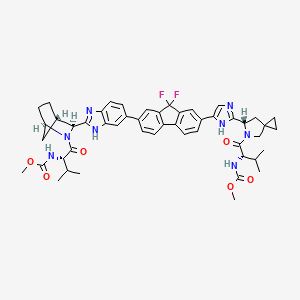



1. Gs-5885
2. Gs5885
3. Ledipasvir Acetonate
4. Methyl ((1s)-1-((1r,3s,4s)-3-(5-(9,9-difluoro-7-(2-((6s)-5-(n-(methoxycarbonyl)- L-valyl)-5-azaspiro(2.4)hept-6-yl)-1h-imidazol-4-yl)-9h-fluoren-2-yl)-1h-benzimidazol-2-yl)-2-azabicyclo(2.2.1)heptane-2-carbonyl)-2-methylpropyl)carbamate
1. 1256388-51-8
2. Gs-5885
3. Gs5885
4. Ledipasvir Acetonate
5. Gs 5885
6. Ledipasvir [usan]
7. Chebi:85089
8. Who 9796
9. 013te6e4wv
10. Ledipasvir (usan)
11. Unii-013te6e4wv
12. Methyl N-[(2s)-1-[(6s)-6-[5-[9,9-difluoro-7-[2-[(1r,3s,4s)-2-[(2s)-2-(methoxycarbonylamino)-3-methylbutanoyl]-2-azabicyclo[2.2.1]heptan-3-yl]-3h-benzimidazol-5-yl]fluoren-2-yl]-1h-imidazol-2-yl]-5-azaspiro[2.4]heptan-5-yl]-3-methyl-1-oxobutan-2-yl]carbamate
13. Methyl N-[(2s)-1-[(6s)-6-[5-[9,9-difluoro-7-[2-[(1s,2s,4r)-3-[(2s)-2-(methoxycarbonylamino)-3-methylbutanoyl]-3-azabicyclo[2.2.1]heptan-2-yl]-3h-benzimidazol-5-yl]fluoren-2-yl]-1h-imidazol-2-yl]-5-azaspiro[2.4]heptan-5-yl]-3-methyl-1-oxobutan-2-yl]carbamate
14. Methyl [(2s)-1-{(6s)-6-[4-(9,9-difluoro-7-{2-[(1r,3s,4s)-2-{(2s)-2-[(methoxycarbonyl)amino]-3-methylbutanoyl}-2-azabicyclo[2.2.1]hept-3-yl]-1h-benzimidazol-5-yl}-9h-fluoren-2-yl)-1h-imidazol-2-yl]-5-azaspiro[2.4]hept-5-yl}-3-methyl-1-oxobutan-2-yl]carbamate
15. Ledipasvir Acetonate [jan]
16. Ledipasvir [usan:inn]
17. Ledipasvir [mi]
18. Ledipasvir [inn]
19. Ledipasvir [vandf]
20. Ledipasvir [who-dd]
21. Schembl2706494
22. Chembl2374220
23. Ledipasvir [orange Book]
24. Schembl15116943
25. Gtpl11271
26. Dtxsid90154829
27. Ex-a411
28. Harvoni (ledipasvir + Sofosbuvir)
29. Harvoni Component Ledipasvir
30. Bdbm50505966
31. Mfcd25976756
32. Ledipasvir Component Of Harvoni
33. Zinc150338819
34. Cs-1653
35. Db09027
36. Ncgc00378990-02
37. Ncgc00378990-05
38. Ac-28378
39. As-56214
40. Hy-15602
41. Methyl ((1s)-1-((1r,3s,4s)-3-(5-(9,9-difluoro-7-(2-((6s)-5-(n-(methoxycarbonyl)- L-valyl)-5-azaspiro(2.4)hept-6-yl)-1h-imidazol-4-yl)-9h-fluoren-2-yl)-1h-benzimidazol-2-yl)-2-azabicyclo(2.2.1)heptane-2-carbonyl)-2-methylpropyl)carbamate
42. (non-isotopelabelled)ledipasvir-13c2, D6
43. D10442
44. Q15409409
45. Carbamic Acid, N-((1s)-1-(((6s)-6-(5-(9,9-difluoro-7-(2-((1r,3s,4s)-2-((2s)-2-((methoxycarbonyl)amino)-3-methyl-1-oxobutyl)-2-azabicyclo(2.2.1)hept-3-yl)-1h-benzimidazol-6-yl)-9h-fluoren-2-yl)-1h-imidazol-2-yl)-5-azaspiro(2.4)hept-5-yl)carbonyl)-2-methylpropyl)-, Methyl Ester
46. Methyl ((s)-1-((s)-6-(5-(9,9-difluoro-7-(2-((1r,3s,4s)-2-((methoxycarbonyl)-l-valyl)-2-azabicyclo[2.2.1]heptan-3-yl)-1h-benzo[d]imidazol-6-yl)-9h-fluoren-2-yl)-1h-imidazol-2-yl)-5-azaspiro[2, Aldrichcpr
47. Methyl ((s)-1-((s)-6-(5-(9,9-difluoro-7-(2-((1r,3s,4s)-2-((methoxycarbonyl)-l-valyl)-2-azabicyclo[2.2.1]heptan-3-yl)-1h-benzo[d]imidazol-6-yl)-9h-fluoren-2-yl)-1h-imidazol-2-yl)-5-azaspiro[2.4]heptan-5-yl)-3-methyl-1-oxobutan-2-yl)carbamate
48. Methyl N-[(1s)-1-[(5s)-5-[5-[9,9-difluoro-7-[2-[(1s,2s,4r)-3-[(2s)-2-(methoxycarbonylamino)-3-methyl-butanoyl]-3-azabicyclo[2.2.1]heptan-2-yl]-3h-benzimidazol-5-yl]fluoren-2-yl]-1h-imidazol-2-yl]-6-azaspiro[2.4]heptane-6-carbonyl]-2-methyl-propyl]carbamate
49. Methyl=[(2s)-1-[(6s)-6-[5-[9,9-difluoro-7-[2-[(1r,3s,4s)-2-[n-(methoxycarbonyl)-l-valyl]-2-azabicyclo[2.2.1]heptane-3-yl]-1h-benzoimidazole-6-yl]-9h-fluorene-2-yl]-1h-imidazole-2-yl]-5-azaspiro[2.4]heptane-5-yl]-3-methyl-1-oxobutane-2-yl]carbamate
| Molecular Weight | 889.0 g/mol |
|---|---|
| Molecular Formula | C49H54F2N8O6 |
| XLogP3 | 7.4 |
| Hydrogen Bond Donor Count | 4 |
| Hydrogen Bond Acceptor Count | 10 |
| Rotatable Bond Count | 12 |
| Exact Mass | 888.41343780 g/mol |
| Monoisotopic Mass | 888.41343780 g/mol |
| Topological Polar Surface Area | 175 Ų |
| Heavy Atom Count | 65 |
| Formal Charge | 0 |
| Complexity | 1820 |
| Isotope Atom Count | 0 |
| Defined Atom Stereocenter Count | 6 |
| Undefined Atom Stereocenter Count | 0 |
| Defined Bond Stereocenter Count | 0 |
| Undefined Bond Stereocenter Count | 0 |
| Covalently Bonded Unit Count | 1 |
When used in combination with the antiviral medication [sofosbuvir] as the commercially available product Harvoni, ledipasvir is indicated for the treatment of HCV genotypes 1, 4, 5, and 6 with or without [ribavirin] depending on the level of liver damage or cirrhosis. Its use has also proven successful in the treatment of HCV in patients co-infected with HIV.
FDA Label
Ledipasvir acts against HCV and is categorized as a direct-acting antiviral agent (DAA). At a dose of 120 mg twice daily (2.67 times the maximum recommended dosage), ledipasvir does not prolong QTc interval to any clinically relevant extent.
Antiviral Agents
Agents used in the prophylaxis or therapy of VIRUS DISEASES. Some of the ways they may act include preventing viral replication by inhibiting viral DNA polymerase; binding to specific cell-surface receptors and inhibiting viral penetration or uncoating; inhibiting viral protein synthesis; or blocking late stages of virus assembly. (See all compounds classified as Antiviral Agents.)
Absorption
When given orally, ledipasvir reaches its maximum plasma concentration in about 4 to 4.5 hours with a maximum concentration (Cmax) of 323 ng/mL.
Route of Elimination
Following a single 90 mg oral dose of [14C]-ledipasvir, mean total recovery of the [14C]-radioactivity in feces and urine was approximately 87%, with most of the radioactive dose recovered from feces (approximately 86%). Unchanged ledipasvir excreted in feces accounted for a mean of 70% of the administered dose and the oxidative metabolite M19 accounted for 2.2% of the dose. These data indicate that biliary excretion of unchanged ledipasvir is a major route of elimination, with renal excretion being a minor pathway (approximately 1%).
In vitro, no detectable metabolism of ledipasvir was observed by human CYP1A2, CYP2C8, CYP2C9, CYP2C19, CYP2D6, and CYP3A4. Evidence of slow oxidative metabolism via an unknown mechanism has been observed. Following a single dose of 90 mg [14C]-ledipasvir, systemic exposure was almost exclusively to the parent drug (>98%). Unchanged ledipasvir is the major species present in feces.
The median terminal half-life of ledipasvir is 47 hours.
Ledipasvir is an inhibitor of the Hepatitis C Virus (HCV) NS5A protein required for viral RNA replication and assembly of HCV virions. Although its exact mechanism of action is unknown, it is postulated to prevent hyperphosphorylation of NS5A which is required for viral production.
